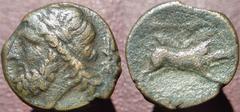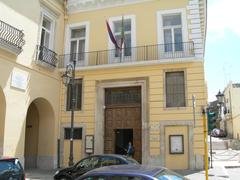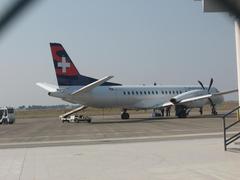Stadio Pino Zaccheria: Visiting Hours, Tickets, and Your Essential Guide to Foggia’s Historic Stadium
Date: 14/06/2025
Introduction
Stadio Pino Zaccheria is not only the home ground of Foggia Calcio but also a cherished landmark embodying the city’s rich sporting history and cultural identity. Since its inauguration in the 1920s, the stadium has evolved from humble beginnings to a modern venue hosting football, community events, and historical milestones. Its central location in Foggia allows visitors to delve into the local football passion and easily combine their stadium tour with visits to the city’s main historical sites, such as the Foggia Cathedral and Palazzo Dogana (calciofoggia1920.net; FoggiaReporter; Tuttostadi; giornaledipuglia.com).
This detailed guide covers everything you need to know about Stadio Pino Zaccheria: its history, practical information for visitors, current renovations, accessibility, FAQs, and tips for exploring Foggia’s nearby attractions.
Table of Contents
- Historical Overview
- Visitor Information
- Cultural Significance
- Exploring Nearby Attractions
- Frequently Asked Questions (FAQ)
- Summary & Planning Tips
- References
Historical Overview
Origins and Early Development (1920s–1930s)
Stadio Pino Zaccheria’s story began in the early 1920s, born from the ambitions of the Sporting Club’s founders who realized Foggia needed a modern venue for the city’s burgeoning football culture. In 1925, a 21,600 sq.m. plot was acquired, and the stadium debuted with a wooden grandstand and a perimeter wall. Financial challenges were overcome through resourceful events, including hosting a Giro d’Italia stage finish (manganofoggia.it). In 1928, the city council took over, ensuring its public status and expanding the facility (calciofoggia1920.net).
Growth and Sporting Milestones (1930s–1950s)
The 1930s solidified the stadium’s role as Foggia’s sporting heart, hosting its first Serie B championship in 1933. An athletics track was added in 1938, and during WWII, the stadium was repurposed for military use. After the war, it became a venue for diverse events, from boxing exhibitions with Joe Louis to American-style rodeos. Post-war funds enabled new stands and improved facilities (calciofoggia1920.net).
Dedication to Pino Zaccheria and Cultural Significance
In 1946, the stadium was renamed after Pino Zaccheria—a local sports pioneer, basketball founder, and WWII hero—symbolizing the city’s intertwining of sporting excellence and civic memory (calciofoggia1920.net). The venue remains central to Foggia’s collective identity and pride, serving generations of supporters.
Modernization and Notable Events (1960s–1990s)
The stadium underwent significant expansion in the 1960s, paralleling Foggia Calcio’s rise to Serie A. Iconic moments include the 1964 victory over Inter and the debut of a new grass pitch in 1965 (manganofoggia.it). Renovations in the ‘70s, ‘80s, and ‘90s progressively increased capacity and modernized facilities, including the installation of individual seats and new lighting, enhancing safety and comfort (calciofoggia1920.net).
Recent Developments and Ongoing Renovations (2000s–2020s)
From 2015 onwards, the stadium has been the focus of major upgrades, including the dedication of stands and capacity increases. The latest €2.18 million renovation, begun in 2025, will raise capacity to over 15,000 seats, modernize infrastructure, and ensure compliance with Serie B standards—all while home matches continue uninterrupted (giornaledipuglia.com; StatoQuotidiano).
Visitor Information
Visiting Hours
- Matchdays & Events: Open to ticket holders; arrive at least one hour before kickoff.
- Non-Matchdays: Limited access; guided tours or special visits by appointment. Always check the official Foggia Calcio website or contact visitor services for up-to-date schedules.
Tickets & Entry
- Where to Buy: Tickets are available online (Vivaticket), at the stadium’s ticket office on matchdays, or through authorized resellers.
- Pricing: Varies by match and seating section. Advance purchase is recommended for popular games.
- Entry Requirements: Expect security screenings and ID checks. Tickets are often personalized; bring valid identification (Tuttostadi).
Accessibility
- Facilities: Designated seating areas, accessible entrances, and restrooms for visitors with disabilities.
- Assistance: Contact stadium management in advance for specific needs or to arrange support (StatoQuotidiano).
Stadium Layout & Facilities
- Capacity: 25,085 seats (14,530 currently homologated due to ongoing improvements).
- Key Sections: Curva Sud (Piero La Salandra), Curva Nord (Franco Mancini), Tribuna Est, Tribuna Centrale, and premium VIP/press seating (Tuttostadi).
- Amenities: Snack stands, restrooms, basic concessions; cafes and restaurants nearby in the city.
Parking & Transportation
- Parking: Limited spaces around the stadium; fills quickly on matchdays. Arrive early or use public transport.
- Public Transport: Local buses connect the train station and city center with the stadium. Taxis are available.
- By Air: Gino Lisa Airport (2.5 km away) offers the quickest access; Bari Airport is around 130 km away (Tuttostadi).
Accommodation Options
- Numerous hotels and guesthouses within walking distance cater to all budgets. Booking early is recommended, especially around major events (Tuttostadi).
Matchday Experience & Atmosphere
- Expect a lively, passionate crowd—especially in the Curva Sud and Curva Nord, known for vibrant displays and chants.
- For families or a quieter experience, Tribuna Centrale seating is ideal.
- Avoid wearing rival team colors in home supporter sections.
Special Events & Guided Tours
- Guided tours are occasionally available and offer behind-the-scenes access. Book in advance, especially during renovation periods.
Photographic Spots
- Best exterior shots: main façade and entrances.
- Inside: Curva Sud and Curva Nord for atmospheric photos.
Cultural Significance
Stadio Pino Zaccheria is a living monument to Foggia’s resilience, community spirit, and sporting legacy. It is named after Pino Zaccheria, a local hero whose story is celebrated as a model of dedication and courage (Wikipedia). The stadium has hosted international matches, legendary Italian clubs, and even major concerts, cementing its place in the city’s lore (FoggiaReporter; StadiumDB).
The stadium is deeply woven into Foggia’s social fabric, serving as a gathering point for fans, families, and the broader community. Events beyond football—including concerts and civic celebrations—further reinforce its role as a cultural hub (StadiumDB).
Exploring Foggia: Nearby Attractions
- Basilica Cattedrale di Foggia: An architectural gem showcasing Baroque splendor.
- Piazza Umberto Giordano: The heart of city life.
- Palazzo Dogana: A UNESCO-listed site reflecting Foggia’s historic importance.
- Borgo Serpente & Chiesa del Carmine: Explore local shops and cafes in this vibrant neighborhood (Wanderlog).
Frequently Asked Questions (FAQ)
Q: What are the stadium’s visiting hours?
A: Primarily open during matchdays and special events; guided tours by appointment. Confirm via official sources before visiting.
Q: How can I purchase tickets?
A: Buy online at Vivaticket, at the stadium’s ticket office, or authorized outlets.
Q: Is the stadium accessible for disabled visitors?
A: Yes, with dedicated seating, entrances, and facilities. Contact management for specific needs.
Q: Are guided tours available?
A: Yes, though availability may vary due to renovations. Advance booking is recommended.
Q: Is there parking at the stadium?
A: Parking is available but limited, especially on matchdays. Public transport is recommended.
Q: What nearby historical sites can I visit?
A: The Foggia Cathedral, Palazzo Dogana, and Piazza Umberto Giordano are all close by.
Summary & Planning Tips
Stadio Pino Zaccheria is a must-visit destination for sports fans and cultural explorers alike. Its history, passionate matchday atmosphere, and ongoing modernization provide an engaging experience that bridges Foggia’s past and present. For the best experience:
- Check official channels for visiting hours, ticket availability, and renovation updates.
- Book tours or tickets in advance, especially for major games or events.
- Combine your stadium visit with a tour of Foggia’s historic center.
- Use public transport or arrive early if driving.
- Download travel apps and follow local resources for real-time updates.
The stadium remains a vibrant symbol of Foggia’s community, sporting spirit, and cultural resilience (giornaledipuglia.com; StatoQuotidiano; calciofoggia1920.net; FoggiaReporter; Tuttostadi).
References
- Stadio Pino Zaccheria: History, Visiting Hours, Tickets, and Things to Know in Foggia (calciofoggia1920.net)
- Exploring Stadio Pino Zaccheria: Visiting Hours, Tickets, and Cultural Significance (FoggiaReporter)
- Stadio Pino Zaccheria Renovations, Visiting Hours, Tickets & Nearby Attractions (giornaledipuglia.com)
- Renovations and Accessibility (StatoQuotidiano)
- Complete Guide to Tickets, Hours, and Nearby Attractions (Tuttostadi)
- Stadium Information and Travel Tips (Wanderlog)
- Stadium History (manganofoggia.it)
- Stadium Overview (StadiumDB)
- Wikipedia Entry (Wikipedia)
Images and interactive content: For the best experience, view high-quality images of the stadium exterior and stands, and use official interactive maps for navigation. Always check the latest updates before your visit.


